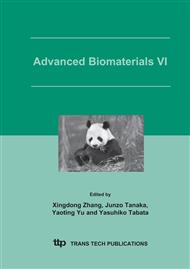p.299
p.303
p.307
p.311
p.315
p.319
p.323
p.327
p.331
Surface Modification of Titanium Implant and In Vitro Biocompatibility Evaluation
Abstract:
The improvement of the amount of OH functional groups and bioactivity of titanium metal was attempted by chemical treatment and subsequent hot water treatments. The surface morphology, chemical composition and crystal structure were used to characterize the Ti surfaces and their biocompatibility was evaluated by culturing with osteoblasts. Porous network bioactive anatase were prepared by immersion in the 5 M NaOH at 80ı for 24 h, followed by soaking in the water at 80ı for 48 h. The treatment with H2O2/HCl solution at 80ı for 30 min followed by hot water aging also produced an anatase titania gel layer. Percentage of surface OH groups was determined by XPS analysis. After chemical treatment and subsequent aging in hot water, the amount of surface OH groups increased. The modified Ti surface promoted the proliferation and the ALP activities of osteoblasts. These results indicate that the NaOH or H2O2/HCl treatment and subsequent hot water immersion improve the biocompatibility of Ti samples. On the other hand, a high OH group concentration is very important as functional groups for the apatite nucleation or biochemical modification via an organometallic interface of immobilizing biomolecules.
Info:
Periodical:
Pages:
315-318
Citation:
Online since:
June 2005
Authors:
Keywords:
Price:
Сopyright:
© 2005 Trans Tech Publications Ltd. All Rights Reserved
Share:
Citation:


